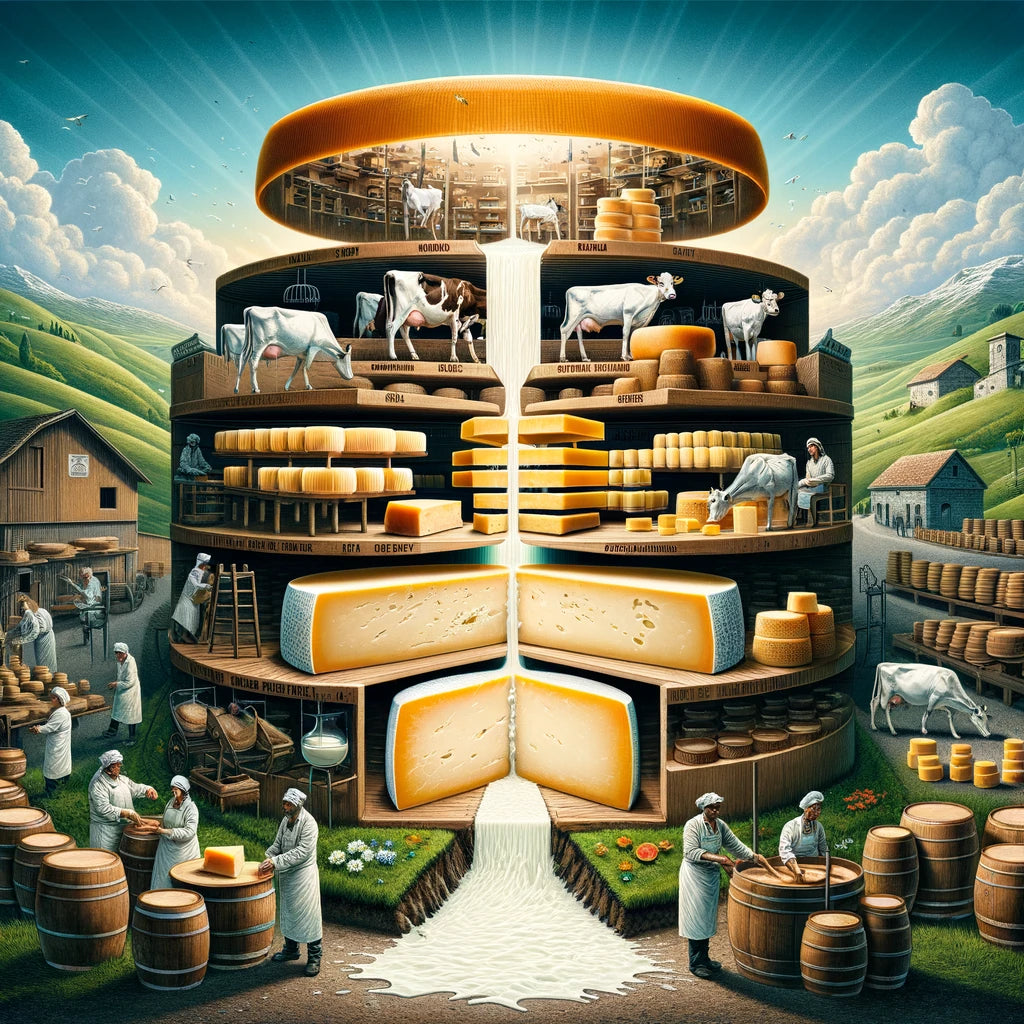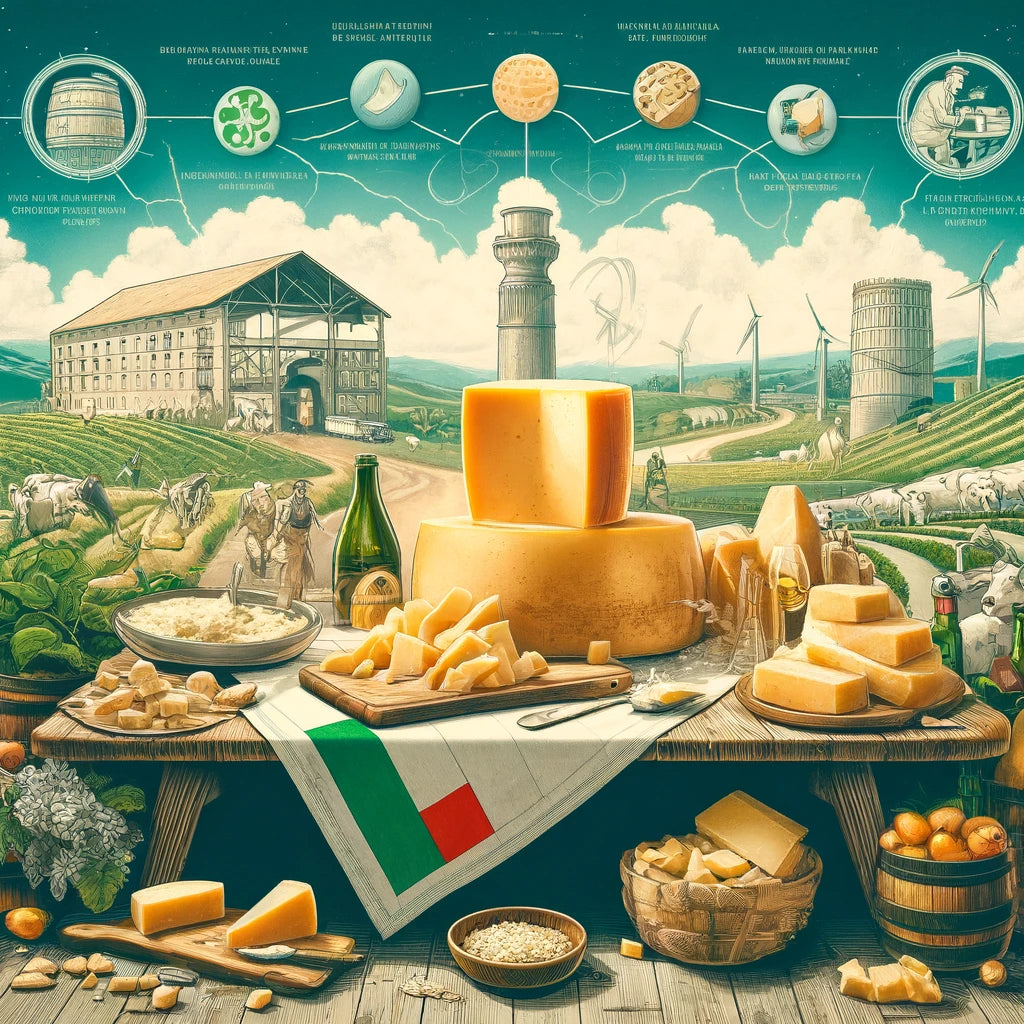Role of Milk Quality and Aging in Determining Parmesan Cheese Quality
The journey of parmesan cheese, a staple in culinary traditions worldwide, begins with the foundational element of high-quality milk. The composition of milk, including its fat, protein, and mineral content, is pivotal in shaping the cheese's eventual flavor, texture, and nutritional profile. This is especially relevant in the context of Unprocessed Cheese, where the natural qualities of the milk are paramount.
Grass-fed Cows: The Impact on Milk Quality
Parmesan's distinctive rich, nutty flavor and granular texture are largely attributed to the milk of grass-fed cows. These cows roam freely, grazing on a natural diet that significantly impacts the milk's quality. The diet of the cows is a crucial factor, with a direct correlation to the presence of beneficial fatty acids and antioxidants in the milk. This natural approach to dairy farming highlights the essence of unprocessed cheese, where minimal processing ensures the milk's inherent qualities shine through in the final product.
Seasonal Variations: A Dance of Flavors
Just as wine enthusiasts celebrate the terroir's influence on grape quality, cheese connoisseurs appreciate the seasonal variations in milk. These fluctuations introduce a delightful complexity to Parmesan, with subtle shifts in flavor and aroma reflecting the changing pasture conditions throughout the year. This dynamism adds a layer of sophistication to cheese tasting, inviting a deeper exploration of each wheel's unique character.

The Art and Science of Aging: Crafting Excellence
Aging, or affinage, is where Parmesan truly transforms, developing its signature characteristics over time. This process is an intricate ballet of biochemical reactions, occurring under the watchful eye of skilled cheesemakers. It's here that we see a parallel with modern cheese innovations, including vegan and plant-based cheese varieties, which also rely on aging techniques to develop flavor and texture, albeit through different methodologies.
The Role of Time: Aging Parmesan to Perfection
The aging process of Parmesan can range from a minimum of 12 months to over 36 months. This prolonged maturation period allows for the evaporation of moisture and the development of flavor through the breakdown of proteins and fats into smaller, flavorful compounds. The cheese's texture evolves, becoming denser and more crumbly, with the formation of characteristic crystals that add a delightful crunch.
Temperature and Humidity: The Environmental Alchemists
In the aging cellars, temperature and humidity are meticulously controlled, mimicking the ancient caves where cheeses were traditionally matured. These conditions are crucial for fostering the growth of beneficial molds and bacteria, which contribute to the cheese's complexity. Modern vegan cheese and plant based cheese makers draw inspiration from these traditional techniques, adapting them to create dairy-free options that satisfy the palate with rich, umami flavors.
A Culinary Staple: Parmesan in the Kitchen
Parmesan cheese, with its robust flavor profile, is a versatile ingredient that enhances a myriad of dishes, from classic Italian pastas to innovative culinary creations. Its ability to elevate simple ingredients into gourmet experiences makes it a favorite among chefs and home cooks alike. In this context, the rise of vegan cheese and plant-based cheese options offers an inclusive approach to culinary traditions, ensuring that even those following dairy-free diets can enjoy the rich, savory flavors that cheese adds to dishes.
Beyond Parmesan: The Evolution of Cheese
As consumer preferences evolve, so too does the cheese industry. The demand for low fat cheese, mozzarella cheese block, and the best mozzarella cheese in India reflects a global appetite for diverse cheese experiences. Similarly, the popularity of Mozzarella Cheese underscores the universal love for cheese, driving innovation in dairy and dairy-free products alike.
The Aging Process: A Symphony of Time and Nature
The maturation of Parmesan is akin to a symphony, where time itself is the conductor, and the natural elements of milk play the orchestra. This intricate performance unfolds in the aging cellars, where each wheel of cheese is nurtured into reaching its full potential.
Complexity Through Time
A Parmesan wheel aging beyond the 12-month mark begins to reveal a more complex flavor profile, characterized by deeper savory notes and a firmer texture. This evolution continues up to and beyond 36 months, where the cheese acquires a crystalline texture and a rich concentration of flavors. It's within this period that Parmesan transforms from a mere ingredient to a standalone masterpiece, capable of elevating any dish it graces.
Environmental Alchemy
The controlled conditions of temperature and humidity in the aging facilities are not merely for preservation but for enhancing the cheese's maturation. The environment acts as an alchemist, subtly shifting the cheese's composition to achieve a balance between moisture, flavor, and texture. This delicate balance is crucial, mirroring the precision required in producing high-quality vegan cheese and plant-based cheese options, where texture and flavor are paramount.
Parmesan Cheese: The Quintessence of Culinary Flexibility
Parmesan's role in culinary arts cannot be overstated. Its application transcends simple gratings over pasta dishes, becoming a key ingredient in pestos, a crunchy addition to salads, and a flavor enhancer to soups and risottos.
Innovative Uses in Modern Cuisine
As culinary boundaries continue to expand, so too do the ways in which Parmesan is utilized. From being incorporated into savory biscotti to acting as a crust for meats, the cheese's versatility is unmatched. This adaptability inspires the creation of vegan cheese and plant-based cheese variants, designed to offer similar flexibility in vegan and vegetarian recipes.

The Rise of Dairy-Free Alternatives
The growing demand for dairy-free options has led to significant innovations in vegan cheese production. Utilizing nuts, soy, and other plant bases, these alternatives aim to replicate the umami and texture of traditional cheeses like Parmesan. While the process differs, the goal remains the same: to produce a cheese that can stand on its own or complement dishes with as much versatility and flavor as its dairy counterparts.
Looking Forward: The Future of Cheese
As we continue to explore the depths of traditional cheese-making, we are also on the cusp of a new era in cheese production. The development of vegan cheese and plant-based cheese options not only caters to dietary preferences and restrictions but also opens up a new realm of culinary creativity.
Sustainability and Ethics
The production of dairy-free cheeses reflects a growing concern for sustainability and animal welfare. By adopting plant-based ingredients, these cheeses offer an environmentally friendly alternative to traditional dairy products, aligning with the ethical considerations of a significant portion of consumers.
The Ongoing Journey of Innovation
The cheese industry is one of tradition as much as it is of innovation. As we delve further into the possibilities of dairy-free alternatives, the lessons learned from centuries of cheese-making continue to guide us. The future promises a blend of tradition and innovation, where the essence of beloved cheeses like Parmesan is captured in every slice, whether dairy or plant-based.
Conclusion
The legacy of Parmesan cheese is not just preserved in its taste or the methods of its making but is also carried forward into the future through the evolution of cheese itself. As we embrace vegan cheese and plant-based cheese options, we honor the tradition of cheese-making by ensuring that everyone, regardless of dietary choices, can experience the joy and depth of flavors that cheese brings to our lives.








